- Home
- Actividades
- Ciudadanía Americana
- Comunismo
- Economía
- Estadidad
- Estudios
- "La Gran Potencia Del Caribe" – Bernardo Vázquez
- All Politics Is Local – Tip O'Neill
- Anotaciones Para La Campaña
- Citizenship In The American Empire – Cabranes
- Cómo Ganar Elecciones – Napolitan
- Creación del PNP
- Documentos Históricos de Puerto Rico
- El Arte de la Guerra – Sun Tzu
- El Príncipe de Maquiavelo
- Filosfía Politíca
- Historia de los Partidos Políticos de PR – Bolívar Pagán
- La Retranca del ELA – Dávila Colón
- Los Protocolos De Los Sabios – Parodia Política
- Memorias del Amolao
- On the Nature of War – Clausewitz
- Slogans
- UN MENSAJE A GARCIA
- FashionClothingshirt
- general
- Historia
- No lo Hagan
- Política
- Anotaciones para la Campaña Estadista – Pompy González
- Campaña
- Candidatos
- Comentarios Diarios de Actualidad
- Corupción
- Deportes
- Economía
- Educación
- Izquierdistas
- Justicia
- Links Pro-Americanos
- Mala Administración PPD y Neo-Comunistas
- Municipios y Precintos
- Neo-Comunistas
- PIP
- PIP – Escritos y Noticias
- PNP
- PNP – Escritos y Noticias
- Pobreza
- Política en Latinoamérica
- PPD
- PPD – Escritos y Noticias
- Retiro
- Salud
- Seguridad
- Status
- Trabajo
- Salud
- Seminarios
- Status
- Videos
- Voluntarios Estadistas
- Vídeos
- Indices – Libros y Links Estadistas
- Lucha E51
- UNETE A: @EstadoPRUSA seminarios-pnp.com
- Libros de Estrategia y Campaña Política
- Temas
- Tertuliando
- «Sin Miedo» gritan los Dirigentes Populares que tienen Miedo
- Temas Estadistas Actuales Para Tertulias y Actividades
- Líderes de la Estadidad
- Gobierno publica estados financieros auditados del 2022 y anuncia pasos para regresar a los mercados
- My Calendar
- No debe ocurrir una primaria Novo progresista – Por Dr. José M. Saldana
- Defendiendo la Rectora de la Escuela de Medicina – O Separatistas la Destruyen
- Cuatro libros indispensables – Por Mario Ramos Méndez – Historiador
- Pierluisi y el Desarrollo Económico Logrado Mejor Que muchas Décadas
- Sobre las candidaturas de agua – Por Iván Rivera
- El nacimiento e influencias revolucionarias del Movimiento Pro-Independencia de Puerto Rico – Por Mario Ramos Méndez
- La corrupción que no tiene fin – Por Mario Ramos Méndez
- Realidad Colonial: Lucha entre Biden y Trump – Por Dr. José M. Saldaña
- La isla de los piratas – PorMario Ramos Méndez, Historiador
- Ya es hora de actuar localmente pues Trump continúa prevaleciendo en las primarias – Por Dr. Jos’e M. Saldaña
- Pedro Pierluisi Incansable por Puerto Rico
- Si los Americanos nos Hacen Iguales es la Mejor Independencia – De Diego
- Muñoz y el sueño derrotado – Por Mario Ramos Méndez
- ¿Que es la estadidad? – Jerry Acosta
- Estadistas Ganan Posiciones en Votaciones Partido Demócrata – marzo 2024
- Los Separatistas Comunistoides
- La nueva secretaria de Educación – Por Mario Ramos
- La Próxima Y Severa Crisis Por Venir! – Minoria de Uno
- LA CUARTA REVOLUCION INDUSTRIAL Y SUS EFECTOS!
- Página Pedro Pierluisi y Para el Voto Ausente y Adelantado
- Santa Cló como tradición puertorriqueña – Mario Ramos Méndez 22/12/2023
- No El voto extranjero en el P. de la C. 1891 – Por Andrés L. Córdova
- Pierluisi y el Desarrollo Económico Logrado Mejor Que muchas Décadas
- La Estadidad para Puerto Rico más Cerca que Nunca
- #82558 (sin título)
- Comparación Económica Estados y Puerto Rico – 2020
- Para el PN P Ganar Cada Municipio
- Programa Federal Instalar Paneles Solares
- ¿Somos viables como pueblo?
- La decisión del gobernador sobre LUMA
- Convocan a manifestaciones en contra de la estadidad y a favor de la descolonización Publicado el junio 20, 2021 por estado51prusa
- Puerto Rico’s ‘Tax Haven’ Isn’t Causing Inequality, Its Territorial Status Is
- SILA Calderón opinando – Por José M. Saldaña
- PNP le contesta al PIP: “tenemos mandato del Pueblo”
- ¿Que es la estadidad? – Jerry Acosta
- Nacionalismo? Por Mario Ramos
- 2019 Presidential candidates discovering Puerto Rico – Por Kenneth McClintock
- La Realidad Cubana que Victoria Ciudadana Aspira
- Amplio Respaldo USA a la Estadidad para ZpR
- El vínculo indisoluble de la ciudadanía americana
- Estado51PRUSA-Blog
- “Tienen una carga importante de trabajo”, dice Pierluisi sobre la nómina de confianza del DE
- Sobre la Asamblea Demócrata, las Primarias del PNP y el 2024!
- Integrarán más personas con diversidad funcional en el gobierno
- Pierluisi: «Por cada Crítica Hay Cientos de Obras»
- Solicitudes de voto adelantado ya están disponibles en el PNP
- Una agenda ideológica – Por Mario Ramos Méndez
- Pierluisi afirma que «este no es el momento» para convocar un plebiscito de estatus
- Trump criticizes Biden’s treatment of Puerto Rico – The San Juan Star
- Amigo de JGo dice que fue «inducida a error» al aspirar por la gobernación
- SALIDA SUMARIA DE LA MARINA DE PUERTO RICO
- NO TE DEJES CONFUNDIR DILE NO A LA NACIÓN VIRTUAL
- Oreste Ramos Lee la columna de opinión de Mario Ramos Méndez
- La agresora corrupción – Lee la columna de opinión de Mario Ramos Méndez aquí
- Los estadistas independientes – Por Mario Ramos Méndez
- Contáctanos
The English landed at Jamestown in 1607… but first, they stopped in Puerto Rico – by Steve Goldberg
Students are capable. Let them take control of their own learning. The results may astonish you. My name is Steve Goldberg. I teach U.S. History at Research Triangle High School. The ideas expressed here are my own, not those of my employer. I constantly work to create a learning environment that allows students to become empathetic global citizens.
The English landed at Jamestown in 1607… but first, they stopped in Puerto Rico
What I Learned Today A teacher modeling empathetic global engagement
The English landed at Jamestown in 1607… but first, they stopped in Puerto Rico
Posted on September 28, 2014 by Steve Goldberg
The English arrived in Jamestown, Virginia, in 1607.
Well, everyone knows that, right? Let’s move on.
Hold on, I told my students. History is all about asking questions.
Don’t you have any questions?
Nope. We’re good.
In an effort to get my students thinking, I asked them two very basic questions about that seemingly simple sentence.
How many ships did the English colonists have with them? And what was the weather like when they took their trip? Did they leave in June or January?
These seem like trivial questions, but they led my U.S. History students on a cool journey of discovery and empathy.
One of my students did some quick in-class research, and found this Wikipedia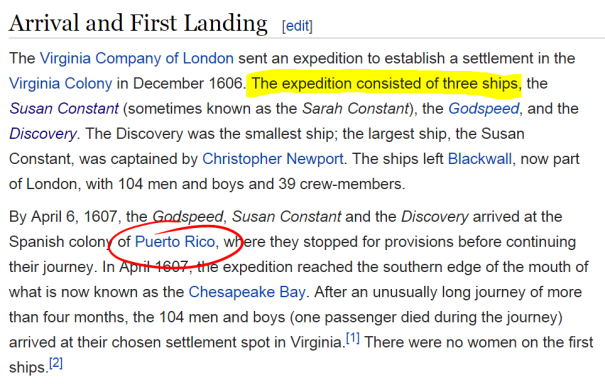 article about the History of Jamestown, which answered my question — there were three ships. And if you look at the start of the second paragraph, it says they landed in April, so it must have been lovely weather. Case closed. Let’s move on…
article about the History of Jamestown, which answered my question — there were three ships. And if you look at the start of the second paragraph, it says they landed in April, so it must have been lovely weather. Case closed. Let’s move on…
three ships
But wait a second — if we take a moment to read the second paragraph beyond the names of the three ships, we learn that these ships crossed the Atlantic and arrived not at Jamestown, but at the Spanish colony of Puerto Rico, where they apparently stopped to get provisions before venturing north. Take a second look:
PR
This stop in Puerto Rico is significant because it reminds 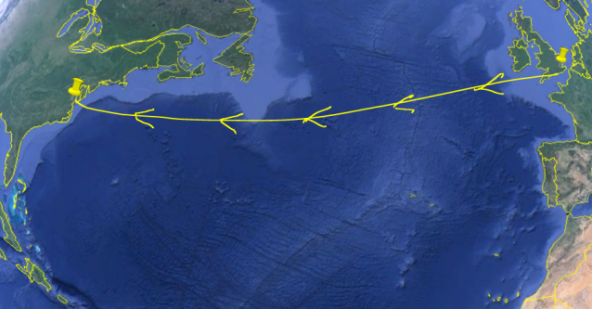 us that the Spanish were all over the “new world” long before the English entered the picture. Thanks to this information about the stop in Puerto Rico I now have a different mental picture of what the English colonists’ route looked like.
us that the Spanish were all over the “new world” long before the English entered the picture. Thanks to this information about the stop in Puerto Rico I now have a different mental picture of what the English colonists’ route looked like.
Before, I pictured something like this:
london-jamestown
But now, armed with new information about the stop in Puerto Rico (how long did they stop for? Did the English have a Spanish translator on their boats? Did some kids growing up in England take Spanish as a second 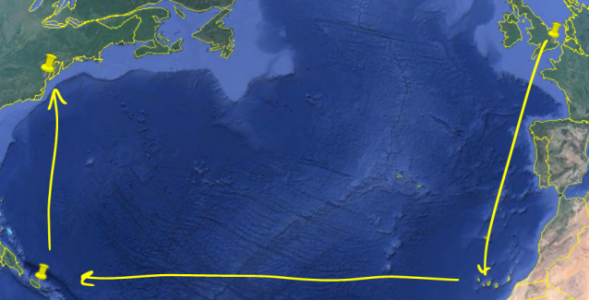 language?), I now picture this route:
language?), I now picture this route:
PR included(the first stop to the south, by the way, would be the Canary Islands — also the stopping point for Christopher Columbus back in 1492.)
columbus 1492
I have since learned that the reason for this seemingly roundabout route (down, left, back up) had everything to do with ocean currents. Here’s a map showing the initial sailing routes between England and Virginia:
traditional route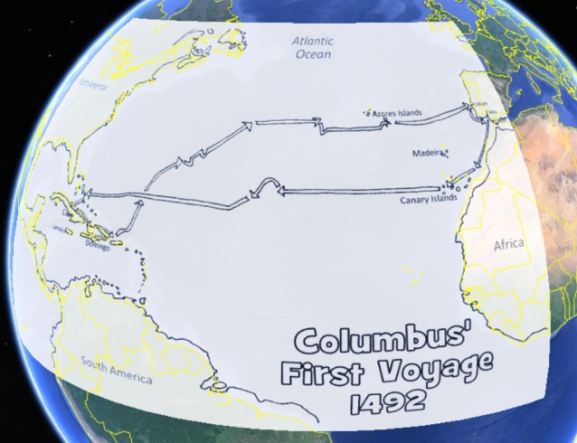
And here’s more detail, from a website dedicated to colonial shipping routes:
The National Park Service describes the typical 1500’s transatlantic sail from England as follows:
Following the clockwise flow of winds and currents, the expeditions sailed south from England, past Spain and Portugal, and stopped over at the Canaries, Madeiras, or Cape Verdes for food and water before attempting the long Atlantic crossing. In the absence of major obstacles, such as foul weather or pirates, this leg of the voyage usually took ten to fourteen days.
Then, with the northeasterly trade winds and the Equatorial Current at their backs, the voyagers made for the West Indies, sailing as a later generation of English square-rig sailors would say “south ’til the butter melts, then west.” An uneventful crossing usually required four or five weeks.
After replenishing supplies once again, the fleet picked up 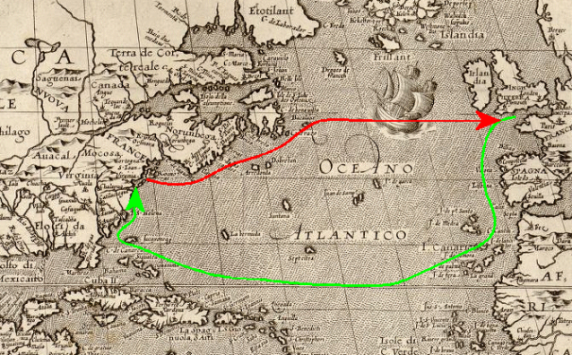 the Florida Current (precursor of the Gulf Stream) and followed it northeast from around the Strait of Florida to the latitude of Roanoke – a trip of another ten days to two weeks.
the Florida Current (precursor of the Gulf Stream) and followed it northeast from around the Strait of Florida to the latitude of Roanoke – a trip of another ten days to two weeks.
For the return trip to England, ships usually took the Gulf Stream and its extension, the North Atlantic Drift, back to Europe, perhaps with a stop in the Azores for provisions and prize ships. Being more direct, the homeward voyage usually took much less time.
So now, if we look back at the two paragraphs from the History of Jamestown Wikipedia article, we have more context for understanding just how unusual it would be for a trip across the Atlantic to take more than four months:
4 months
The people on that boat must have been sick of sailing!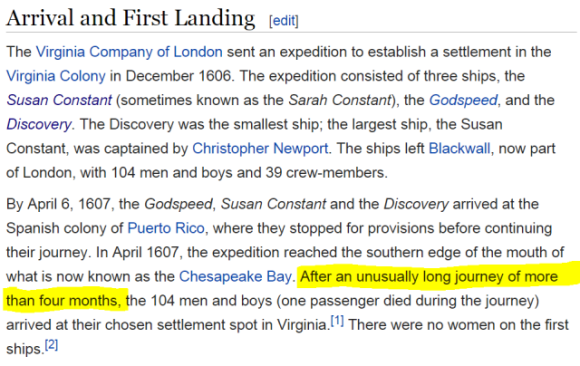
So when did they leave London? In order to arrive in Virginia in April of 1607, the people on these three ships must have left London in December of 1606. And in fact, that’s just what happened, according to this website about Jamestown from the National Park Service:
On December 6, 1606, the journey to Virginia began on three ships: the Susan Constant, the Godspeed, and the Discovery. In 1607, 104 English men and boys arrived in North America to start a settlement. On May 13 they picked Jamestown, Virginia for their settlement, which was named after their King, James I. The settlement became the first permanent English settlement in North America.
The site for Jamestown was picked for several reasons, all of which met criteria the Virginia Company, who funded the settlement, said to follow in picking a spot for the 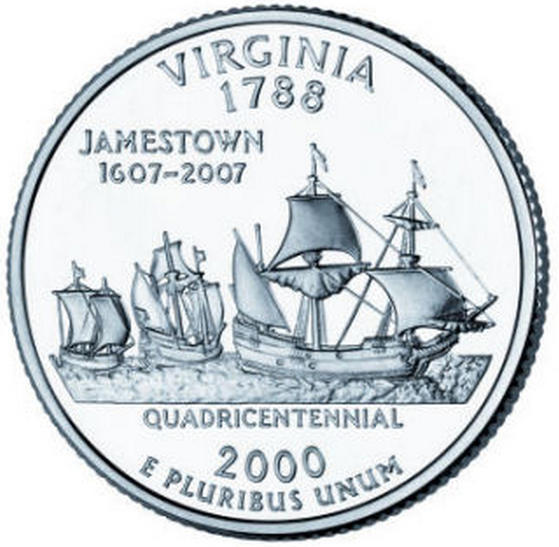 settlement. The site was surrounded by water on three sides (it was not fully an island yet) and was far inland; both meant it was easily defensible against possible Spanish attacks. The water was also deep enough that the English could tie their ships at the shoreline – good parking! The site was also not inhabited by the Native population.
settlement. The site was surrounded by water on three sides (it was not fully an island yet) and was far inland; both meant it was easily defensible against possible Spanish attacks. The water was also deep enough that the English could tie their ships at the shoreline – good parking! The site was also not inhabited by the Native population.
Because we were not satisfied with the simple sentence that so many students memorize — The English arrived in Jamestown, Virginia, in 1607 — and because we consulted multiple sources, we started to empathize with the people on those boats. We thought about sea currents and weather and language barriers.
It matters how many boats there were — and it matters what time of year it was. It also matters that there were no women on the boats. It all matters. And the more you can stop to empathize, the more history comes to life and becomes more than just a flashcard to remember.
And for the record, it turns out there’s a quicker way to find out how many ships went on the journey — just look on the back of the state quarter for Virginia:
quarter
About these ads
Related
It’s hard to learn from multiple choice
Reblogged by 1 person
Let students guide (and own) the learning
Why doesn’t Japan have a military?
With 1 comment
About Steve Goldberg
I teach U.S. History at Research Triangle High School, a public charter school in Durham, NC, whose mission is to incubate, prove and scale innovative models of teaching and learning.
View all posts by Steve Goldberg →
This entry was posted in Uncategorized. Bookmark the permalink.
← Doing Flips — Flipped Attendance and a Flipped TestWho is Kailash Satyarthi? →
2 Responses to The English landed at Jamestown in 1607… but first, they stopped in Puerto Rico
Antonio Monroig-Malatrasi says:
July 18, 2016 at 3:00 pm
San Juan was founded in 1521 so at the time they stopped in Puerto Rico the city was 78 years old.
Reply
Verena Franciscus says:
July 18, 2016 at 4:30 pm
Fascinating. Thank you. I wish all history teachers were like you! Good luck!
Reply







You must be logged in to post a comment Login